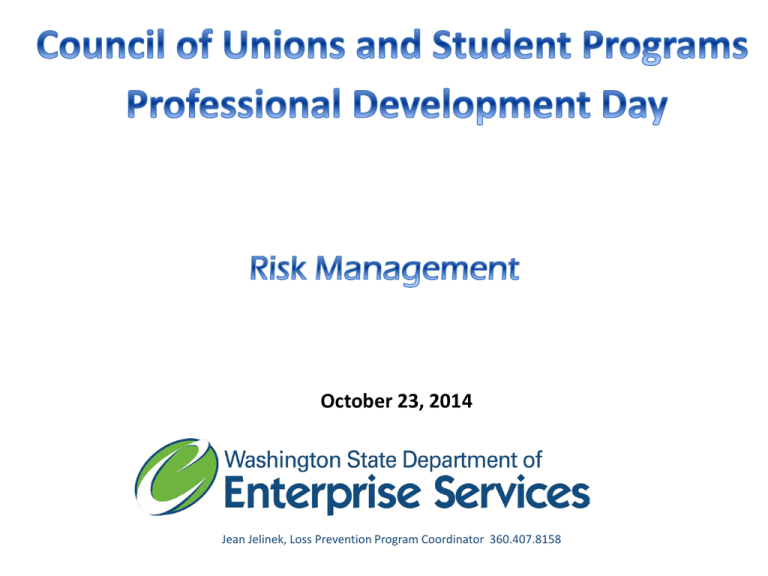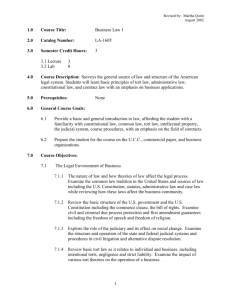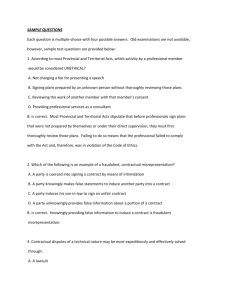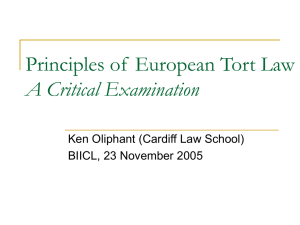October 23, 2014 Jean Jelinek, Loss Prevention Program Coordinator 360.407.8158
advertisement

October 23, 2014 Jean Jelinek, Loss Prevention Program Coordinator 360.407.8158 Overview During this session, we will cover: – When bad things happen: a brief introduction to tort liability and commercial insurance – Preventing bad things: an introduction to enterprise risk management (ERM) • Presentation by AAG John Clark • Risk discussion/panel Potential risks – broad categories • State property is damaged (e.g., building damaged in an earthquake, data is lost, vehicle is totaled in a collision) – might be covered under commercial insurance • Student is injured at school – might be covered by student’s health care insurance bought by the student or by an insurance policy bought by the organization • Employee is injured at work – might be covered by workers compensation • State employee is negligent -- does something in the course of their work that damages someone else’s property, injures another person or violates someone’s civil rights –– could result in a tort claim / law suit, which might be covered under Self Insurance Liability Program A word about tort claims • Tort = breach of a duty owed to another person (excluding breach of contract) • Typically, states have sovereign immunity (from early English law can’t sue the King) • Washington waived immunity in 1961 • Agencies can be sued just like private persons • A tort claim must be filed prior to a lawsuit • ORM works to resolve tort claims short of litigation • AGO defends the state in litigation Self Insurance Liability Program • Washington is self-insured – RCW 4.92.130 • SILP is administered by DES Office of Risk Management (ORM) and pays for claims against: – State agencies, state employees and volunteers acting within the scope of their employment – Defense costs • Examples of what is covered by SILP: – Bodily injury or property damage to a third party – Violations of civil rights • Examples of what is not covered by SILP: – Worker injuries (covered by workers compensation or the Jones Act) – The state’s own losses, such as property damage (commercial insurance can be purchased to cover property losses) Risk Financing Commercial Insurance Available coverage (organization must contact ORM to purchase): • • • • • • • • • • • • • • • • • Accidental death & dismemberment (AD&D) – Covers non-instructional activities policy such as performing arts, talent show, Christmas boutique (excess insurance; health care plan is primary) Athletic insurance program –Provides AD&D benefits for authorized participants of scheduled, college sponsored games and practices. Auto – For buses, trucks, etc. Most cars are covered by SILP. Aviation – For airport and aviation liability Boiler & machinery (HVAC equipment breakdown) Bonds – e.g., public employees fidelity bond Fine arts – e.g., to cover loaned art collection Foreign liability – Foreign trips for employees (auto and general liability, repatriation) Marine – ferry and non ferry policies, pollution Master property (physical damage (including earthquake and flood) to scheduled buildings, electronic data processing equipment, contents and loss of income Medical student intern general liability (damage equipment) Medical student intern professional liability (medical malpractice) Non-medical student intern professional liability (e.g., shop) Out-of-state workers compensation (required if employee works >30 days in another state in a year) Student injury and sickness insurance – medical coverage for registered students taking 60 or more credit hours per quarter Special event liability coverage (haunted house, graduation) Club sports (non-sponsored, e.g., wrestling, lacrosse) – health insurance bought by students John Christenson 360.407.9461 Enterprise Risk Management Traditional Risk Management • Reactive to incidents, claims, lawsuits • Examines what happened afterwards • Ad hoc Enterprise Risk Management • Proactively considers and treats risks that might affect an organization’s goals • Doesn’t replace traditional risk management activities • Must still respond when bad things happen • Must be prepared for emergencies Department of Enterprise Services State of Washington ERM focuses on the future, not the past. Office of Risk Management Risk Management 101 Parents gave us our first RM lessons: – Identify the risk: look both ways – Assess the risks: how fast is the car going, and how big is it? – Manage the risks: mitigate risk by using crosswalk or wearing reflective clothing – Monitor the risks: as you are crossing, keep an eye out for vehicles Benefits of ERM • Helps organizations reach their strategic goals • Helps organizations meet mandates and statutory requirements • Helps prevent injuries and losses • Protects the assets of the organization • Reduces tort claims and litigation Roadmap to Managed Risk Risk Management Process Identify exposures, risks and opportunities Identifying Risk Based on Goals Enterprise Risk Management • Why does your agency exist? • What are you required to achieve (e.g., legislative mandates)? • What accomplishments are targeted in your strategic plan? What can get in the way of accomplishing your mission? • Some risk cannot be avoided. What is your agency’s “risk tolerance”? Identifying Risk Based on Assets • Real Property – buildings, bridges, etc. • Personal Property – computer systems, records, cash, etc. • Intangible property (reputation, branding, etc.) • Employees What hazards and perils threaten your assets? Risk Identification Methods • • • • • • Safety checklists Surveys Inspections Assessments Brainstorming Review of loss history, accident reports, tort claims, etc. • Industry review • Operations flow chart – identifies critical points, weak links, lack of standards Risk Identification • What are the uncertainties, exposures, perils and hazards facing your organization? – – – – – – – – – – – – – – – – Catastrophic event (earthquake, tsunami, flood) Theft Insufficient number of trained employees Buildings or grounds in disrepair Unsafe driving habits Employment practices Independent contractors Illness, disability, retirement, death of employees Poor morale Terrorism/ active shooter Slip and fall on premises Work-related injuries Lack of safety equipment, non-adherence to safety procedures Cyber threats, lack of data control Budget Risks unique to your institution’s goals, services and assets Six Simple Steps 1. Clearly state the goal Seven Simple Steps (e.g., ‘prepare students for workforce’, or ‘conduct graduation ceremony’) 2. List everything that could keep you from meeting the goal (the ‘risks’) 3. Evaluate each risk: Choose a likelihood rating from 1-5 Choose an impact rating from 1-5 Vote Multiply together & ‘Map’ 4. Prioritize (Pick the most severe risks) 5. Develop a response plan (risk register): Avoid Accept & Monitor Transfer Reduce the likelihood Reduce the impact - Include measures of success 6. Implement and monitor plan Communicate Results Gather & share ‘best practices’ Review & Refine Clearly state the goal Examples: • Fencing club plans to drive to Oregon for tournament • Mountaineering club wants to build a 50 foot outdoor climbing wall Health and Safety Risks? Step 2: Identify potential risks Property Risks? • Brainstorm potential risks • Don’t be bogged down at this step by how likely the risk is, or how you will manage the risk • Consider different areas of risk. A student trip to another state could pose many types of risk Legal and Compliance Risks? Reputation / Credibility Risks? Step 3:Vote to determine risk score • Group would then vote on each risk, using set ranking criteria for likelihood and impact • Take the average likelihood score and multiply it by the average impact score for each risk • Plot the risk scores on a heat map Step 4: Prioritize your risks Sample Heat Map Review potential exposures to determine likelihood and severity • The most severe risks will fall in the ‘Red Zone’. • Unless you have unlimited resources of people, time and money, your initial focus should be on treating risks that fall in the red zone Step 5: Develop a Treatment Plan • Determine how you will treat/mitigate each priority risk – Avoid – Accept and monitor – Reduce the likelihood – Reduce the impact – Transfer the risk via contract or waiver – Insurance Step 5: Create a risk register to list risks, risk scores and treatment plans GOAL: Risk (Briefly describe; include ‘score’) Risk Treatment (Check type and briefly describe) □ □ □ □ □ □ □ □ □ □ □ □ □ □ □ □ □ □ □ □ □ □ □ □ Avoid Accept Reduce Transfer Avoid Accept Reduce Transfer Avoid Accept Reduce Transfer Avoid Accept Reduce Transfer Avoid Accept Reduce Transfer Avoid Accept Reduce Transfer How will we know when we succeed? (What are the ‘measures’?) Target Date Person Responsible Risk Intelligence Many things that make our lives better today are the result of someone taking a calculated risk yesterday. Get in the habit of looking for risks. Ask, “What might get in the way of accomplishing this goal on time?” Ask, “If we do this, what might the consequences be?” Develop a toolkit for managing risk. Know who to call for help. Thank you for participating!








